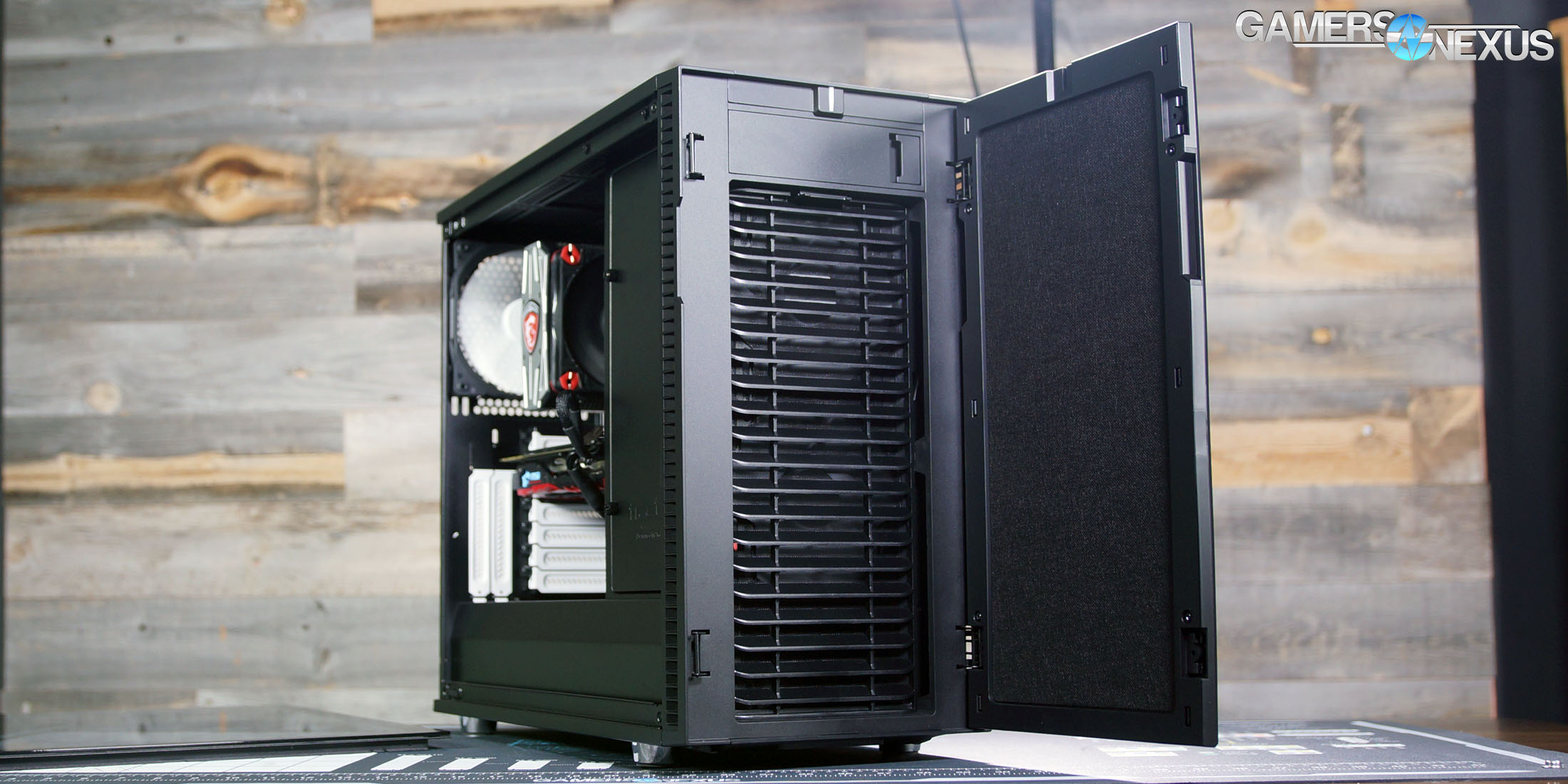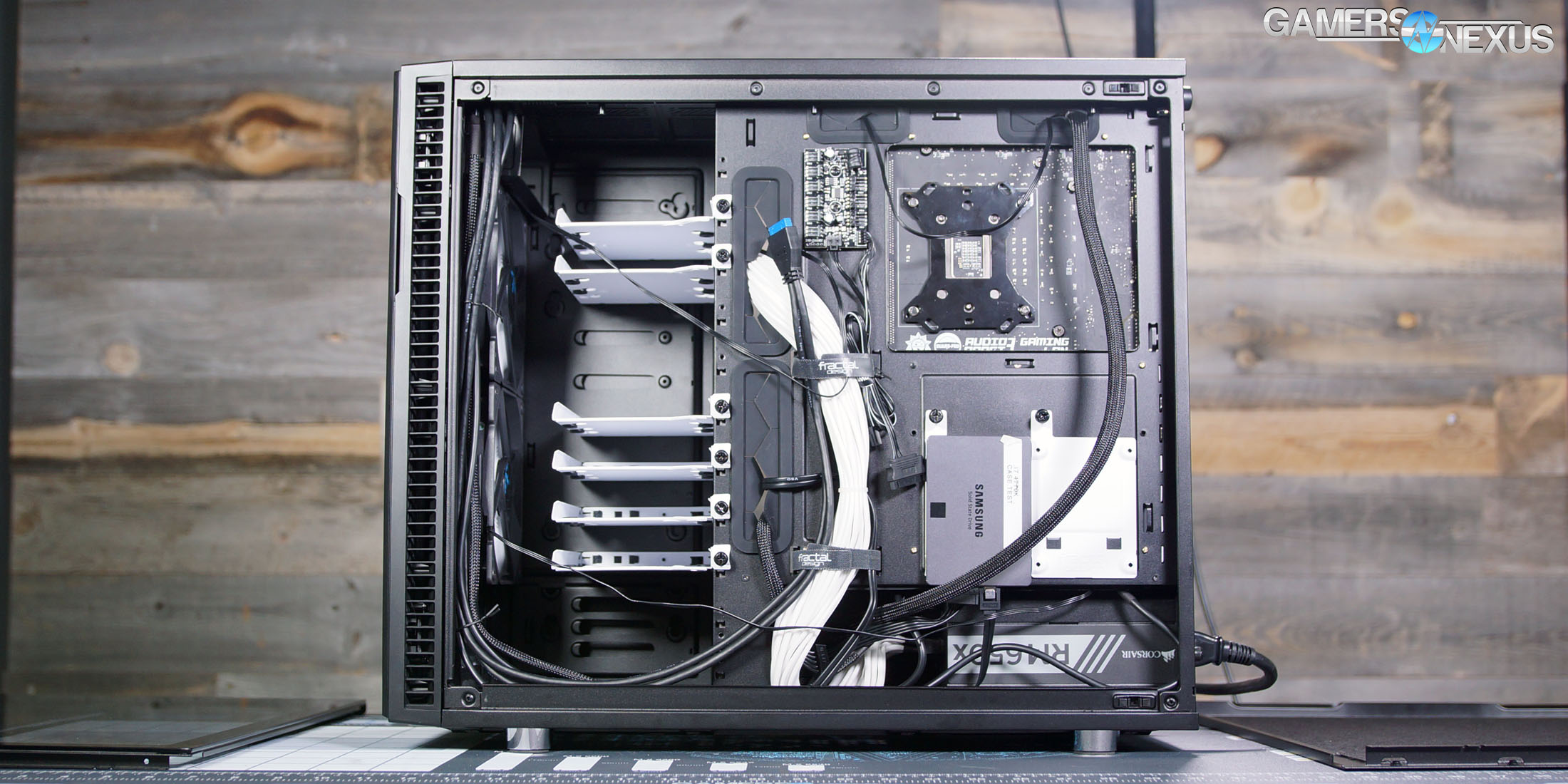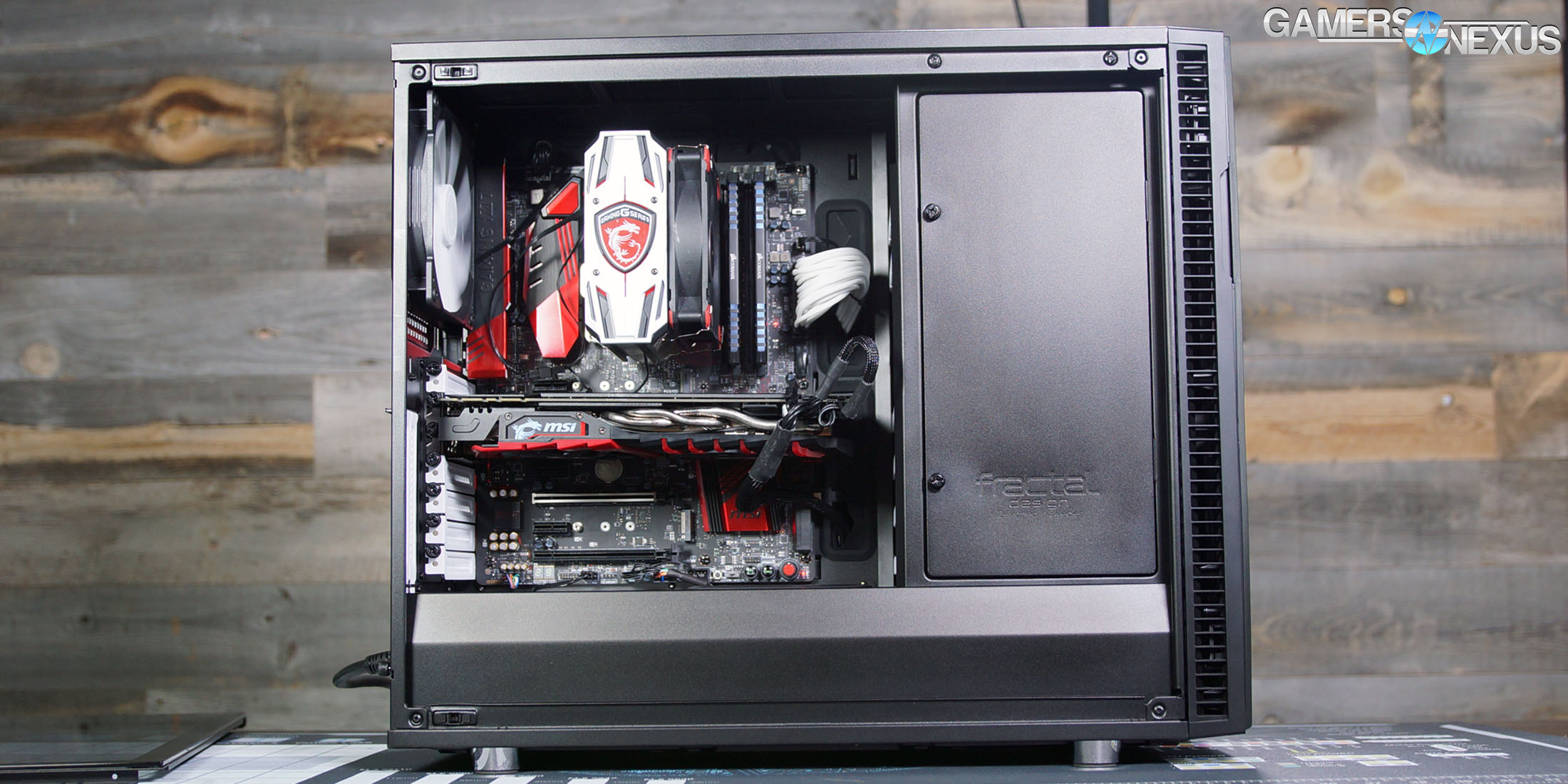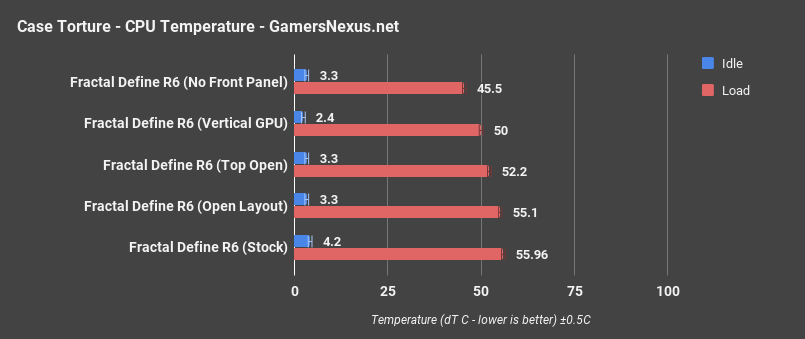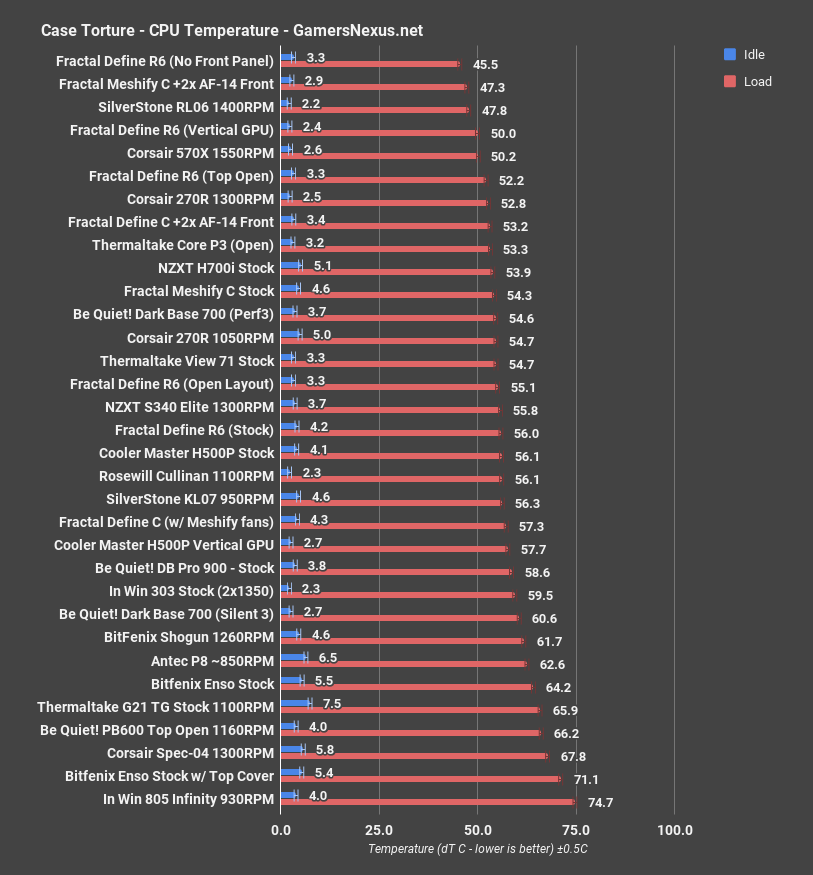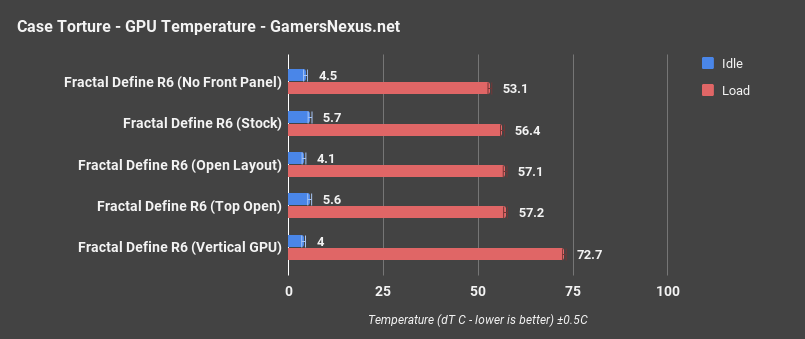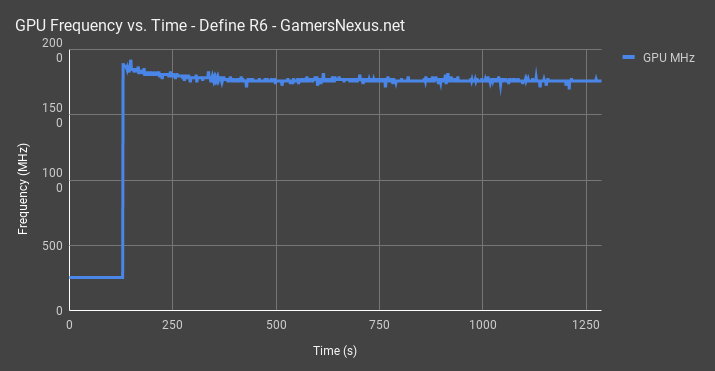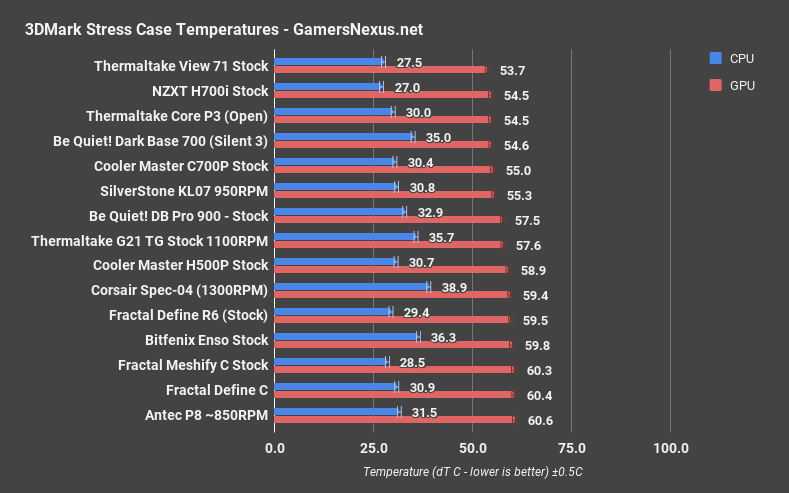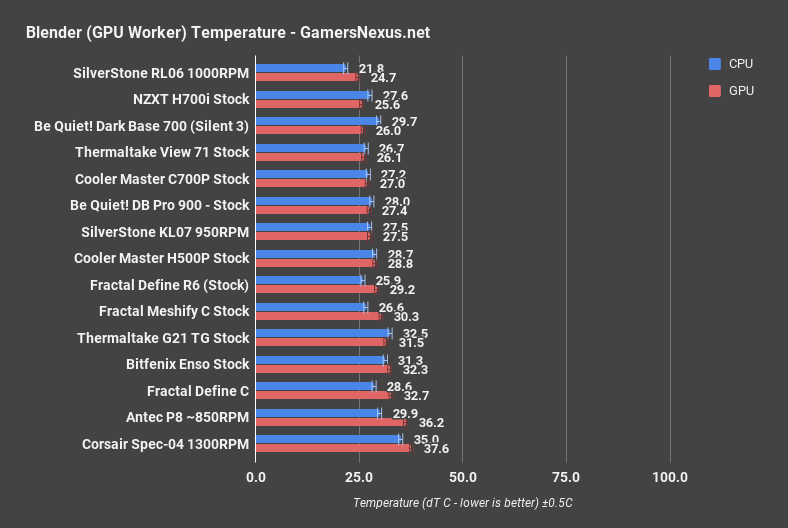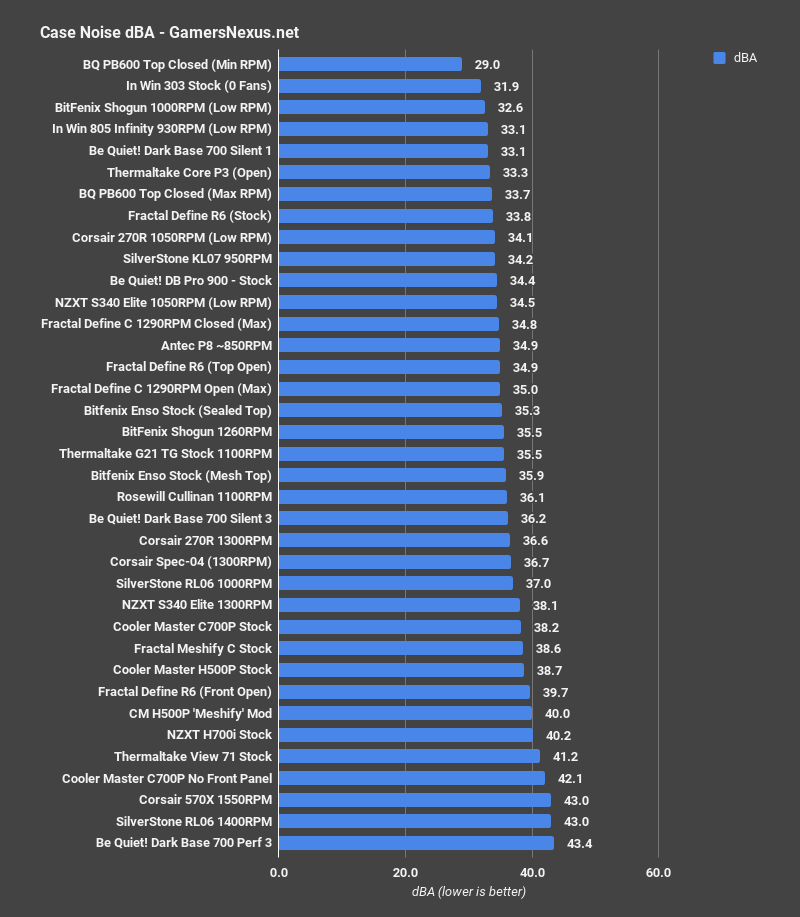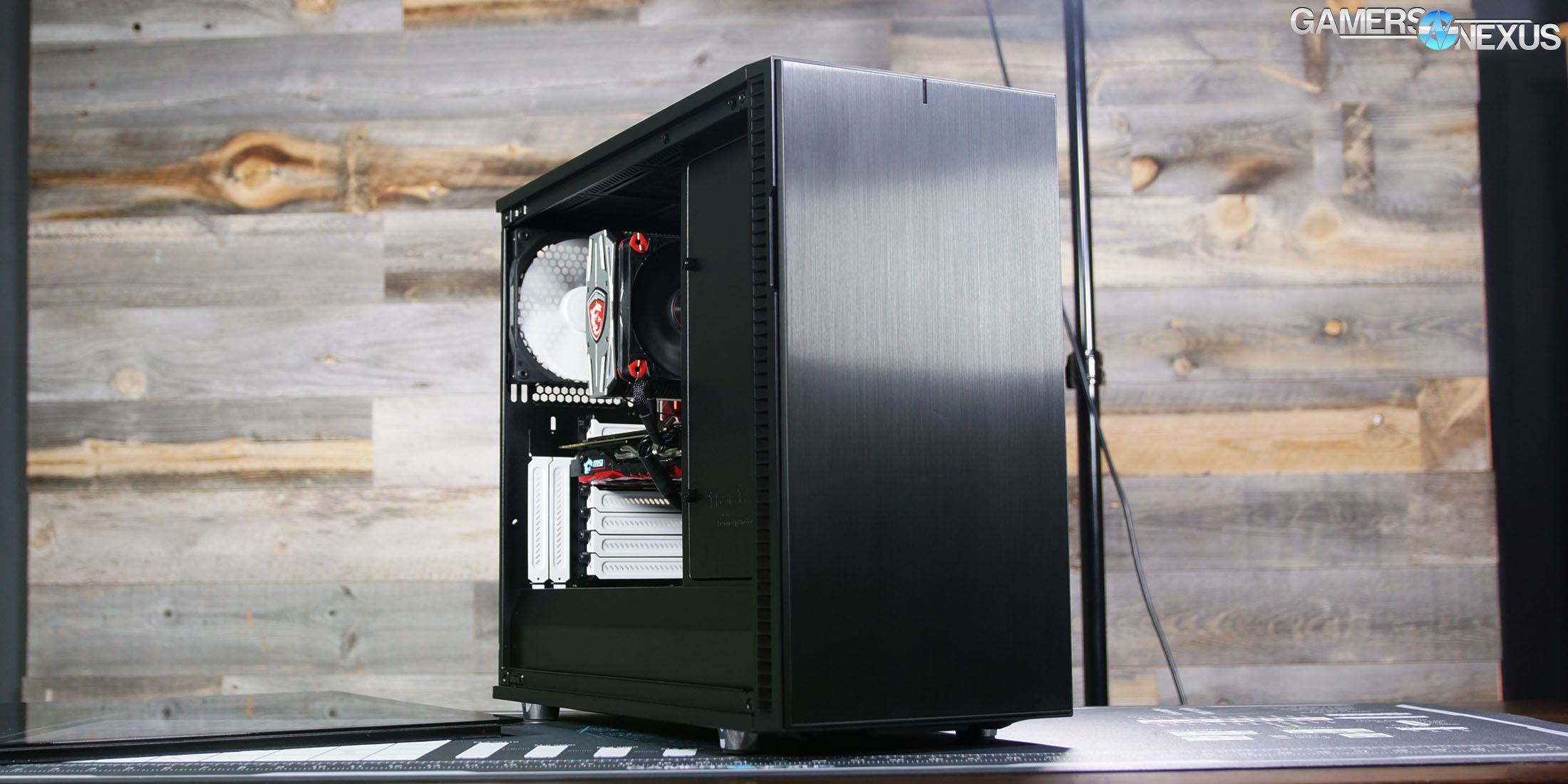We never bothered to review Fractal’s popular Define R5--by the time we got a chance, it was already old news. Since the R5’s release, we’ve reviewed both the Define C (and Meshify C) and given them very high marks. Now, the R5’s successor is here, ready for 2017 with a full PSU shroud and a tempered glass side panel. There are no LEDs, though, so we must all mourn.
OK, mourning over. This Fractal Define R6 review looks at build quality, thermal and acoustic performance, and cable management features. This enclosure is one of the few to impress us in the last few months, given the prevalence of cases like the Bitfenix Enso, and we found the R6’s build quality to be even better than the already-liked Define/Meshify C.
Before getting started, you can find each of these cases on Amazon here:
- Fractal Define R6
- Fractal Meshify C (won our “Best Overall” award for cases)
- Fractal Define C
Fractal Define R6 Specs, Price, Release Date
3.5”/2.5” Universal drive brackets | 6 |
Dedicated 2.5” drive brackets | 2 |
Expansion slots | 7 + 2 vertical |
Motherboard compatibility | eATX (up to 285mm wide), ATX, mATX, ITX |
Power supply type | ATX |
Front ports | 2 x USB 3.0, 2 x USB 2.0 |
Fan mounts | Front: 3 x 120mm or 2 x 140mm, 2 x Dynamic X2 GP-14 included Top: Standard layout:3 x 120 or 2 x 140 Open layout:3 x 120/140 mm Rear: 1 x 120/140mm 1 x Dynamic X2 GP-14 included Bottom: 2 x 120/140mm |
Dust filters | Bottom fan + PSU Front fans Top panel |
Radiators | Front: 120/240/360mm 140/280mm Top: Standard layout : 120/240/360mm Rear: 120mm Bottom: 120/240mm 140/280mm |
PSU Max Length | 300 mm |
GPU Max Length | Max 440mm with front fan mounted Standard layout : Maximum width 155mm (including power connectors) for graphics cards longer than 300mm |
CPU cooler max height | 185mm |
Cable routing space | 23mm |
Glass Panel (on tempered glass version) | Black/Blackout/Gunmetal versions: 33% tinted tempered glass White version: Clear transparent tempered glass |
Case Dimensions (LxWxH) | 543 x 233 x 465mm |
Weight | 12.4 kg |
MSRP | Standard: $130/€130 Tempered glass: $150/€150 |
The R6 is surprisingly heavy: 12.4kg is a couple kilos heavier than its predecessor, which primarily comes down to the glass, but the steel side panels weigh just as much. Black, blackout, white, and gunmetal versions of the case are available, both with and without tempered glass. Our review sample was just “black,” which means white accents on the PCI covers and fan blades. The dark versions come with 33% tinted glass, while the white version’s glass is clear, a refreshing change from white cases with tinting so dark that everything looks grey. Other than the full glass side panel, the case is absolutely a Fractal design (a Fractal Design design?): square, blank, and modern, with vents along the front edge.
Fractal Define R6 Build Quality
The side panels are fastened with thumbscrews, but these are optional and mostly to keep things secure during shipping--the panels lock into place tightly enough without them. With the screws removed, the panels can be hinged outwards a few degrees before fully coming off. This applies to the tempered glass panel as well, which means no holes in the glass with Frankenstein bolts through them. Side panel mechanisms that don’t suck are always welcome, and that goes double for glass.
There’s no wasted space on the interior of the R6. Motherboard installation can be a little cramped without removing the hard drive cages, but there’s still a generously-sized grommeted cutout above the motherboard for the CPU power connector, typically a weak point for compact cases. GN’s Steve may think rubber grommets are a waste of money, but Fractal’s have a clever zig-zag pattern that allows small cables to be routed subtly. Cable management is decent, but there’s so much space inside the PSU shroud that it’s hardly worth worrying about.
The top panel of the R6 is composed of two layers: a standard mesh filter, and a steel plate (backed with acoustic foam) clipped over it. With the steel plate on, the top is completely closed; with it removed, the top is completely open except for the filter. The whole sandwich unlatches and lifts slightly when a button on the rear of the case is pressed, similar to the side panel detachment on the H700i. It doesn’t pop out all the way, though, and needs to be lifted from inside the case, which makes it feel a little pointless. The steel plate was extremely hard to separate from the filter the way the manual said to, even with judicious use of a flathead screwdriver, but was a little easier to pop off from the “wrong” side. It’s an improvement over past ModuVent™ designs (plastic lids that didn’t really deserve a trademarked name), but it could be executed better.
Front I/O includes four USB slots, none of which are type C. This stands out as the one obvious update that hasn’t been made to the case, but never fear: Fractal announced the Connect D1 front I/O kit alongside the R6. This “kit” costs $30 for an entirely new I/O panel that’s identical except for an added USB-C connector. That initially sounds like a ripoff, but it seems likely that the R6 had already gone into production by the time Fractal realized there would be demand for USB Type-C, and that this was the best compromise available. It’s nice to know the kit exists, at least.
Also announced alongside the R6 was the Flex VRC-25 vertical GPU riser kit, slated for availability in late January, 2018. This is a $40 PCIe riser cable with mounting holes to attach to the PSU shroud for extra security. It’s not necessary to buy the official riser cable, but it IS necessary to use one where the card mounts perpendicular to the cable. PSU shrouds with vertical GPU mounts cause trouble: generic PCIe riser cables generally bump up against the shroud and refuse to fit, which is an issue we were constantly dealing with until receiving this cable.
There is a single 5.25” bay included, a somewhat unusual feature in modern cases. It’s just a removable metal rectangle behind a bay cover, but it’s nice to have the option for an ODD, especially in a silent case that could be used as a media PC. Like the R5, the R6 has an oddly fancy 5.25” bay cover with a little latch with a handle that swings out for easy removal.
The hard drive bays are held in place with one captive thumbscrew and a plastic tab that hooks into the chassis. Additional screws can be added for security during transportation, but the thumbscrew is plenty. A metal cover obscures the drive from external view in the standard layout, like the Cooler Master C700P.
One advertised feature of the R6 is the optional “open layout.” The conversion isn’t anything as dramatic as invertible cases like the Dark Base 900, but it’s also a little beyond just removing the hard drive cages. After the 5.25” bay and 3.5” HDD bays are removed, the metal plate used to hide the HDDs can be moved inwards to extend the motherboard tray, like the eATX plate included with the Bitfenix Shogun. This is mostly an aesthetic change, but it does remove some airflow obstructions and allow more clearance for radiators. Liquid cooling support is pretty good for a mid-tower (see the spec chart), and there’s even a space for a fill port under the top cover.
Three Dynamic X2 GP-14 140mm fans are preinstalled. They go for $14 apiece on Newegg and are advertised as being capable of 68.4CFM at 1000RPM, although we typically saw closer to 900RPM on ours (fans tend to have a wide range of manufacturing tolerance). They’re good fans, and they’re fairly quiet (Fractal claims 18.9 dBA). The R6 does come with a fan hub, which supports six three-pin fans and three four-pin. Unlike the R5, there are no external controls for the fan hub, just a PWM header that connects to the motherboard.
The filters are massive. The top, front, and bottom sides of the case are all fully covered by individual filters, which is the most basic and practical approach possible. The one downside to the top filter not being a cheap square of mesh is that it is essentially the top of the case and must always be installed, or else there’s just a big ugly hole left behind. Top exhaust will always be obstructed by the filter, especially with a top-mounted radiator. Still, most users will probably keep the steel plate in place, which prevents top exhaust altogether.
Case Testing Methodology
We tested using our new Skylake case test bench, detailed in the table below. This particular configuration is brand new with the launch of the 570X & 270R. Results on this test platform cannot be compared to previous case benchmark results, as the platform has completely changed.
Conducting thermal tests requires careful measurement of temperatures in the surrounding environment. We control for ambient by constantly measuring temperatures with thermocouples and laser readers. We then produce charts using a Delta T(emperature) over Ambient value. This value subtracts the thermo-logged ambient value from the measured diode temperatures, producing a delta report of thermals. AIDA64 is used for logging thermals of silicon components, including the GPU diode.
All case fans are manually configured to their maximum throughput using BIOS, then we configure to an RPM closer to 1050 for a universal "quiet" testing. If a fan controller is present, we opt-in and test on multiple settings. This forces testing of case fan performance in addition to the case's air channeling and airstream design. This also ensures minimal variance when testing, as automatically controlled fan speeds can reduce reliability of benchmarking. The CPU fan is set to 1100RPM (constant) for consistency, and the CPU is overclocked to 4.4GHz with a vCore of 1.272V (constant). C-States and power saving states are disabled.
| Component | Courtesy Of | Price | |
| Video Card | MSI GTX 1080 Gaming X (OC Mode) | MSI | $640 |
| CPU | Intel i7-6700K @ 4.4GHz | GamersNexus | $300 |
| CPU Cooler | MSI Core Frozr L | MSI | TBD |
| Motherboard | MSI Z170A Gaming M7 | MSI | $180 |
| Memory | Corsair Vengeance LED 32GB 3200MHz | Corsair | $200 |
| SSD | Samsung 850 EVO 120GB | Samsung | N/A |
| PSU | Corsair RM650x | Corsair | $100 |
| Case | This is what we're testing! | - | - |
The video card is configured to run at 55% fan speed at all times.
Prior to load testing, we collect idle temperature results for ten minutes to determine the unloaded cooling performance of a case's fans and air channels. Thermal benchmarking is conducted for 1400 seconds (23 minutes), a period we've determined sufficient for achieving equilibrium. The over-time data is aggregated and will occasionally be compiled into charts, if interesting or relevant. The equilibrium performance is averaged to create the below charts.
Load testing is conducted using Prime95 LFFTs and Kombustor “FurMark” stress testing simultaneously. Testing is completely automated using in-house scripting, and executes with perfect accuracy on every run.
We recently validated our test methodology using a thermal chamber, finding our approach to be nearly perfectly accurate. Learn more here.
For extra tests, we removed the front panel (not just the door), mounted the GPU vertically, opened the top ModuVent, and reconfigured to the “Open Layout.” Removing the front panel has become one of our regular tests, as it provides an absolute best case scenario for airflow that other results can be compared against.
Fractal Define R6 Thermals - CPU Torture (Case Study)
As usual, we’re starting with only temperatures for the Define R6 in different configurations, then we’ll look at comparative data with other cases.
Average CPU temperature during the torture test was 56 degrees Celsius, but dropped to 45.4 degrees with the whole front panel removed. This is a newly standardized test for us, and helps determine how much headroom a case has to thermally improve its design. We’ll have to look at resulting noise levels later, though, to see what the acoustic impact is. This temperature drop is to be expected with all the noise damping and baffles in the way of airflow. Opening the top had a much less dramatic, but still significant impact on temperature, and average CPU temperature was 52.2 degrees. Vertical GPU mounting lowered CPU temperatures, which is an effect we’ve seen before: Vertical GPU mounting gets the radiative heat from the backplate away from the CPU cooler, aiding in CPU temperatures. As for Fractal’s open layout, wherein the drive cages are removed and the side-shroud is relocated, the layout had no real effect on CPU temperatures.
Fractal Define R6 CPU Thermals vs. Define C, Meshify C, H500P, H700i
56 degrees is around what the NZXT S340 Elite, Cooler Master H500P, and stock Define C scored--middle-of-the-chart temperatures that aren’t impressive by themselves, but are made impressive by the R6’s emphasis on silence. This becomes a question of marketing: When the product, like the Bitfenix Enso or the H500P, claims to offer high airflow and low temperatures, it needs to actually do so. In the Define R6’s case, it’s a silence-focused case that manages to keep average temperatures. If the case can deliver lower-than-average noise levels, it’ll be in a good position.
The stock Meshify C and Be Quiet!’s more expensive Dark Base 700 were slightly cooler, but the competing Dark Base Pro 900 and Pure Base 600 were both warmer. Opening the top cover pushed the R6 up quite a few spots, better than anything the Define C achieved with the front panel on, and slightly better than the stock Corsair 270R.
Removing the front panel, expectedly, demonstrates that the R6 could run way cooler with an open face -- but we’ll see if the enclosure makes-up for this in acoustic performance, as that is ultimately its marketing objective.
Fractal Define R6 GPU Thermals (Case Study)
Average GPU temperature was 56.4 degrees in the stock torture test, which only dropped about 3 degrees with the front panel removed--not much room for improvement. Neither opening the top cover nor the open layout had a significant effect on GPU temperature; this makes sense, as neither is particularly beneficial to the airflow path for the GPU. The vertical GPU mount caused a huge temperature increase, as usual, to 72.7C, with a definite decrease in frequency as the GPU diode hit 93 degrees actual temperature. Since Fractal sent us the proper PCIe riser cable, we didn’t have to strap everything together with zip ties and the GPU and CPU coolers didn’t make contact--this is just how it is with air-cooled components in this configuration. As we’ve been saying for 6 months now, vertical GPU mounts for open-face cards just don’t make sense. You’d ideally use this for an open loop configuration, as the liquid makes up for any radiative or airflow disadvantages.
Fractal Define R6 GPU Thermals (Comparative)
Since the GPU is much more aggressive about altering clock speed to lower temperature, the differences between cases are smaller on our GPU chart. 56.4C dT is just 0.2 degrees warmer than what the Meshify C and Define C achieved with extra Noctua intake fans, but it’s still on the warm side of what we consider decent. Both the Be Quiet! DB 700 and DB Pro 900 have lower GPU temperatures, and the (cheaper) Pure Base 600 is roughly equivalent.
A lot of this comes down to that shroud: Although the enclosure gets decent airflow into it -- roughly on-par with a case that has 2x 200mm front fans, no less -- the shroud is trapping some heat from the open face card. There’s not much that can be done about this, aside from focusing more airflow toward the bottom of a chassis.
Fractal Define R6 3DMark
While looping 3DMark’s Firestrike Extreme stress test, average GPU was 59.5 degrees over ambient, about on-par with the Bitfenix Enso and Corsair Spec-04, which is a little embarrassing for a $150 case. The Dark Base 700 was significantly cooler at 54.6C, but both the stock Meshify C and Define C were warmer thanks to their limited stock fans. This can be improved by adding fans, as you’d expect.
Fractal Define R6 Blender
Rendering our blender test on the CPU, average CPU dT was 36.9. That’s cooler than any case we’ve run that test on except the Silverstone RL06, including the DB Pro 900 and DB 700. The R6 is definitely capable of keeping air-cooled CPUs at safe temperatures under load.
However, rendering on the GPU, average GPU dT was 29.2. Relative to other cases, it fared better than it did in Firestrike, but still not enough to compete with the two be quiet! Cases. It did cool better than the Meshify C and Define C, though, and it beat the Enso by 3 degrees. This teaches us that the Define R6 primarily starts struggling with GPU thermals when both the CPU and GPU are under load, as it doesn’t have enough pathways for hot air to escape the enclosure.
Fractal R6 Noise Levels
In stock configuration with fans at max speed, the R6 reached 33.8 dBA. All the baffles and padding really do something, and Fractal’s marketing delivers: with the top cover opened, noise levels increased (measurably, but not audibly) to 34.9 dBA, and with the front panel removed completely, it jumped to 39.7 dBA. 33.8 dBA is almost exactly the same as the Pure Base 600, and the only case that’s quieter at max RPM is the Thermaltake Core P3, because it has no fans.
Conclusion: Fractal Define R6
We’ve praised Fractal in the past for high build quality and logical layouts, and the R6 continues that trend. It’s visually similar enough to the R5 that it makes sense to call it the R6, but it’s still a new and distinct case with logical updates like the tempered glass, the PSU shroud, and less space devoted to ODDs. Fractal advertises the R6 as “designed from the ground up,” and it looks like that’s really true. The R6’s chassis doesn’t seem like it’s been designed to adapt to 8 different case SKUs or a ton of different layouts, because there’s no point: two layouts is enough. There are three fans included, and there’s no real reason to replace them or buy additional fans. It’s a full package, and what you see is what you get. The push button release for the top vent could be either a little less elaborate or a little more useful, but the fact that that’s the only (very minor) complaint with this case is a point in its favor.
Of the cases we’ve tested, be quiet!’s Pure Base 600 is the closest competitor. With the tops sealed and fans at max RPM, the cases are equal in noise levels and GPU cooling, but the Define C has superior CPU cooling. This could change with different fan configurations or liquid cooling, but judging purely by the numbers, Fractal has the advantage. The R6 is well-positioned in price between be quiet!’s budget Pure Base and high-end Dark Base lines, and the tempered glass version is a bit more than the Silent Base 800. The 800 doesn’t have a TG version, though, so for now the Define R6 has little competition in its specific niche.
Editorial, Testing: Patrick Lathan
Video Editorial, Test Lead: Steve Burke
Video: Andrew Coleman
